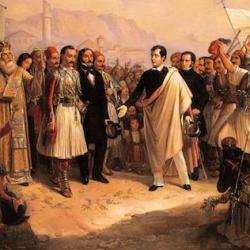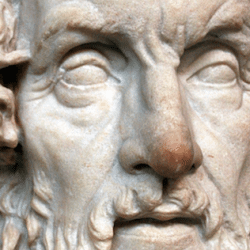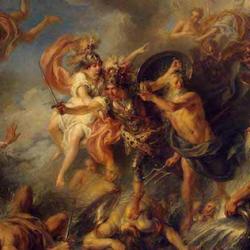Why did the Greeks and Romans sacrifice? The TLS reviewer of two new books on the subject, Smoke Signals for the Gods: Ancient Greek Sacrifice from the Archaic through Roman Periods and Greek and Roman Animal Sacrifice: Ancient Victims, Modern Observers
, summarizes the main theories, which come from Walter Burkert’s Homo Necans: The Anthropology of Ancient Greek Sacrificial Ritual and Myth
The Cuisine of Sacrifice Among the Greeks
, edited by Marcel Detienne and Jean-Pierre Vernant. Both Burkert and Vernant operate on the Durkheimian principle that ritual is more revealing of religion than theology, but they tilt in different directions in their analysis of what sacrifice is for and where it came from.
The reviewer sums Burkert’s argument thus: “Burkert’s electrifying Homo Necans insisted on the act of animal-killing, the sacrificial act par excellence, as the central element of ancient religion. Sacrifice, Burkert argued, had its origins in the Palaeolithic era, when small human bands survived through the pursuit and killing of wild animals. Homo sapiens was originally homo necans, murderous apes organized into communities by the repeated act of killing with spear and blade. In the course of the long Neolithic transition from hunting to agriculture, Burkert suggested, the bloody act of animal-killing gradually became ritualized into sacrifice. When the male citizens of a Greek polis came together to disembowel a terrified and bellowing bull, they were unconsciously re-enacting the violence that had first brought their prehistoric ancestors together.” In short, for Burkert, “Civilized life endures only by giving a ritual form to the brute force that still lurks in men” (Burkert’s words.
Vernant once characterized his difference from Burkert in this comment to Burkert: “To sacrifice is fundamentally to kill in order to eat. But, within this formulation, you put the accent on the killing, I put it on the eating.”
For Vernant and his colleagues, the distribution and consumption of sacrificial food was the central import of sacrifice. Sacrifice bound a community together, sometimes in equality as each consumed an equal portion of meat, sometimes in a hierarchy signaled by the quality and amount of sacrificial food. All sacrifice also ritualized the distance between gods and men, for the gods received smoke, and bones wrapped in fat, while the people ate a different fare. Gods and men were not table companions.
The two books under review aim to go beyond this debate. According to the reviewer, neither is able to do so. Greek and Roman Animal Sacrifice includes critiques of Burkert and Vernant, but without sketching a clear alternative. F.S. Naiden does propose a clear alternative in Smoke Signals , which”offers a massive and sustained challenge to the Durkheimian vision of ancient sacrifice. Naiden thinks that recent writings on sacrifice have ‘overestimated the animal, and underestimated the god.’ Both halves of Vernant’s definition (‘To sacrifice is fundamentally to kill in order to eat’) are firmly rejected. Sacrifice, Naiden argues, ‘did not depend on an animal as opposed to other offerings, or on an animal’s death; it did not evoke guilt, and it did not depend on a community as opposed to an individual.’ Animals were simply ‘offerings that happened to be slaughtered,’ which could be replaced by other kinds of offering – bronze statuettes, fig cakes, incense – without changing the meaning of the ritual. Instead, Naiden insists that we take seriously the Greeks’ own view of sacrifice as a means of communication with the gods.”
Naiden “emphasizes the efforts the Greeks took to make the sacrifice as attractive as possible, in order to maximize the prayer’s chance of success. Victims had their horns gilded, and wore garlands of flowers; humans danced, sang and sometimes even took a bath beforehand.” The purpose was to make the animal more attractive, and hence more acceptable, to Zeus. Besides, Durkheim to the contrary, rituals were not effective merely in their performance, a fact evident in common stories of rejected sacrifice (Naiden assembles 92 instances from ancient literature).
The reviewer is not convinced. Naiden’s approach, like Burkert’s and Vernant’s, is too static, smudging together Homer with late antique evidence. And some of the later evidence doesn’t fit Naiden’s theory very well – such as sacrifices offered to living rulers. In the end, though both books contain a wealth of evidence, neither moves the debate much past Burkert and Vernant. It still appears that killing and eating were pretty central to sacrifice.











